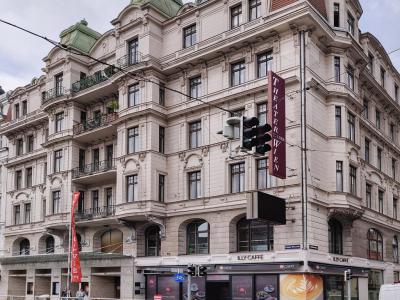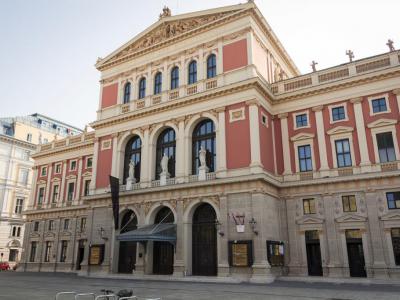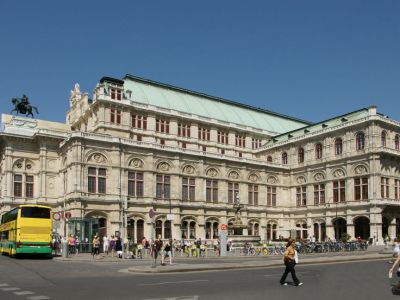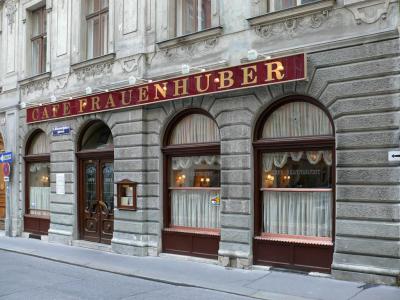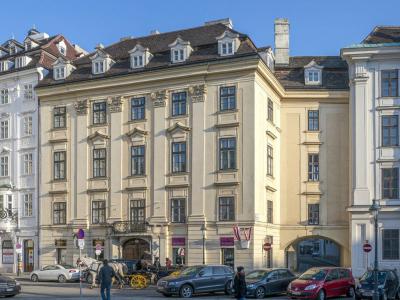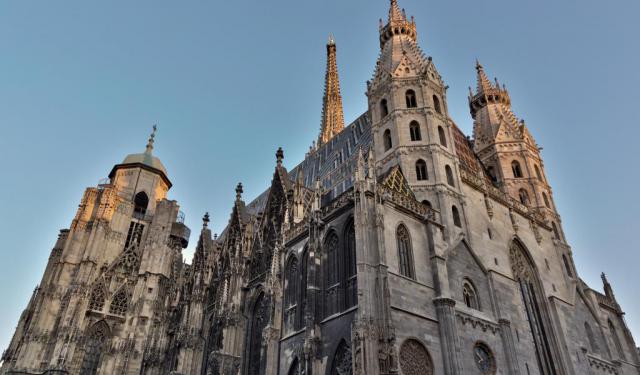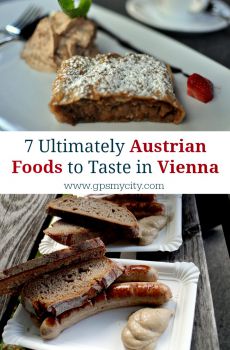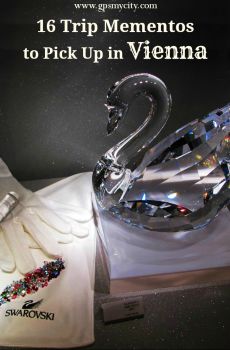Vienna's Historical Music Venues (Self Guided), Vienna
Austria is synonymous with classical music almost to the point of obsession, and to call Vienna the "Musical Capital of the World" would be hardly an exaggeration. Indeed, over the past centuries, the city served as the home and workplace for many great musicians like Wolfgang Amadeus Mozart, Ludwig van Beethoven, Johann Strauss, Joseph Haydn, Franz Schubert, and others.
Among the numerous historical venues that made a mark in the shaping of Vienna's musical heritage, the Musikverein (Vienna Philharmonic) is probably one of the most famous. Stepping inside its Grosser Saal (Great Hall), renowned for its exceptional acoustics, one can easily "surrender one's senses to the symphonic enchantment that echoes through time."
Another iconic landmark, the opulent Wiener Staatsoper (Vienna State Opera), is truly a place "where the spirit of the Viennese opera flourish” and “where dreams are woven into melodies and hearts are carried away on the wings of arias."
The historic Theater an der Wien was also crucial in the development of both opera and operetta. This theater hosted premieres of several of Beethoven's works, such as "Fidelio" opera, as well as Strauss's "Die Fledermaus" (The Bat) and "The Gypsy Baron" operettas.
Cafe Frauenhuber occupies the location that used to be frequented by the likes of Wolfgang Amadeus Mozart and Ludwig van Beethoven, among other musicians, in the late 18th century.
As for Michaelerkirche (St Michael's Church), it has a long-standing tradition of hosting organ concerts and choral performances, much like the Niederösterreich Palace – hosting in the past some renowned premiers by Liszt, Beethoven, and Schubert. The beautiful Baroque-style Collalto Palace, the former residence of Ludwig van Beethoven in the inner city, today may present interest to music enthusiasts and Beethoven aficionados.
While these venues may not represent the entire musical landscape of Vienna – which extends far beyond dedicated concert halls and encompasses a variety of spaces, – they do nonetheless hold historical and cultural significance for those keen to feel the majestic musical embrace of this city.
Among the numerous historical venues that made a mark in the shaping of Vienna's musical heritage, the Musikverein (Vienna Philharmonic) is probably one of the most famous. Stepping inside its Grosser Saal (Great Hall), renowned for its exceptional acoustics, one can easily "surrender one's senses to the symphonic enchantment that echoes through time."
Another iconic landmark, the opulent Wiener Staatsoper (Vienna State Opera), is truly a place "where the spirit of the Viennese opera flourish” and “where dreams are woven into melodies and hearts are carried away on the wings of arias."
The historic Theater an der Wien was also crucial in the development of both opera and operetta. This theater hosted premieres of several of Beethoven's works, such as "Fidelio" opera, as well as Strauss's "Die Fledermaus" (The Bat) and "The Gypsy Baron" operettas.
Cafe Frauenhuber occupies the location that used to be frequented by the likes of Wolfgang Amadeus Mozart and Ludwig van Beethoven, among other musicians, in the late 18th century.
As for Michaelerkirche (St Michael's Church), it has a long-standing tradition of hosting organ concerts and choral performances, much like the Niederösterreich Palace – hosting in the past some renowned premiers by Liszt, Beethoven, and Schubert. The beautiful Baroque-style Collalto Palace, the former residence of Ludwig van Beethoven in the inner city, today may present interest to music enthusiasts and Beethoven aficionados.
While these venues may not represent the entire musical landscape of Vienna – which extends far beyond dedicated concert halls and encompasses a variety of spaces, – they do nonetheless hold historical and cultural significance for those keen to feel the majestic musical embrace of this city.
How it works: Download the app "GPSmyCity: Walks in 1K+ Cities" from Apple App Store or Google Play Store to your mobile phone or tablet. The app turns your mobile device into a personal tour guide and its built-in GPS navigation functions guide you from one tour stop to next. The app works offline, so no data plan is needed when traveling abroad.
Vienna's Historical Music Venues Map
Guide Name: Vienna's Historical Music Venues
Guide Location: Austria » Vienna (See other walking tours in Vienna)
Guide Type: Self-guided Walking Tour (Sightseeing)
# of Attractions: 7
Tour Duration: 2 Hour(s)
Travel Distance: 3.0 Km or 1.9 Miles
Author: leticia
Sight(s) Featured in This Guide:
Guide Location: Austria » Vienna (See other walking tours in Vienna)
Guide Type: Self-guided Walking Tour (Sightseeing)
# of Attractions: 7
Tour Duration: 2 Hour(s)
Travel Distance: 3.0 Km or 1.9 Miles
Author: leticia
Sight(s) Featured in This Guide:
- Theater an der Wien (Opera House)
- Musikverein (Vienna Philharmonic)
- State Opera House
- Cafe Frauenhuber
- Michaelerkirche (St. Michael's Church)
- Niederosterreich Palace
- Collalto Palace
1) Theater an der Wien (Opera House)
Splendid architecturally, well organized, and with a program of shows that hosts the most important artists in Europe year-round, Vinenna's oldest standing theater is a pleasure for tourists. You can read interviews with singers who say that they love it, too, because of its intimacy and the way its acoustics show off the voice.
Theater an der Wien was opened in 1801; a statue above the original Millöckergasse entrance (around the corner from the present main entrance) shows its founder, Emanuel Schikaneder, playing Papageno in Mozart's "The Magic Flute". The building is also closely linked to Beethoven, who lived here while working on "Fidelio" (his only opera, celebrating the triumph of marital love and female heroism over the cruelty of official tyranny), but also to Johann Strauss Jr, whose operetta "Die Fledermaus" was premiered on 5 April 1874 and has been part of the regular repertoire ever since.
The spirit of musical history probably adds to one's enjoyment, but the performances one sees here – including daring performances of 20th- and 21st-century works – are wonderful in themselves: imaginative and effective staging, fine orchestras and choruses, and exceptional singers. Tours of the foyer, auditorium, and stages (with a sneak peek into the cloakrooms and mask collection) sold at the box office cost €7 per person and are a wonderful way to get the entire history and see backstage areas.
Theater an der Wien was opened in 1801; a statue above the original Millöckergasse entrance (around the corner from the present main entrance) shows its founder, Emanuel Schikaneder, playing Papageno in Mozart's "The Magic Flute". The building is also closely linked to Beethoven, who lived here while working on "Fidelio" (his only opera, celebrating the triumph of marital love and female heroism over the cruelty of official tyranny), but also to Johann Strauss Jr, whose operetta "Die Fledermaus" was premiered on 5 April 1874 and has been part of the regular repertoire ever since.
The spirit of musical history probably adds to one's enjoyment, but the performances one sees here – including daring performances of 20th- and 21st-century works – are wonderful in themselves: imaginative and effective staging, fine orchestras and choruses, and exceptional singers. Tours of the foyer, auditorium, and stages (with a sneak peek into the cloakrooms and mask collection) sold at the box office cost €7 per person and are a wonderful way to get the entire history and see backstage areas.
2) Musikverein (Vienna Philharmonic)
Two concert halls in one building, designed in the 1860s with dazzling gilding inside. The larger of the two, the Grosser Saal ("Great Hall"), has some of the best acoustics in the world – along with Berlin's Konzerthaus, the Concertgebouw in Amsterdam, and Boston's Symphony Hall – and is the unofficial home of the great Vienna Philharmonic Orchestra, which gives regular sell-out performances, while the other hall, the Brahms Saal, is used for smaller-scale chamber concerts.
The Musikverein's most prestigious event is the annual New Year's Day concert, a tradition started under the Nazis in 1939, and one which is now broadcast live around the world to an estimated 50 million viewers from 95 countries. If you are lucky to be in Vienna during the regular season (September-June), go for a real concert instead of a tourist-oriented one. While tickets for "proper" concerts may be sold out months in advance, other times they will be on sale up to the start of the performance. In any case, use the official box office on the left side of the building or the official website, as agencies are known to take a hefty commission.
The concert hall itself also has a rich musical history, as the place where Johann Strauss Jr. personally conducted the waltz "Freut Euch des Lebens" (Life Let Us Cherish – composed for the opening ball), and where Arnold Schönberg unleashed atonal music – or as Schönberg preferred to call it, "the emancipation of dissonance" – on an unsuspecting and unready Viennese public.
Why You Should Visit:
The building is intricately beautiful and the guided tour, fascinating.
The area itself is very happening so you should be checking it out.
Tip:
One must enter a computer lottery to win the chance to buy tickets for events, but it is well worth the effort.
One could also get a (cheaper) last-minute standing room ticket if one tries.
The Musikverein's most prestigious event is the annual New Year's Day concert, a tradition started under the Nazis in 1939, and one which is now broadcast live around the world to an estimated 50 million viewers from 95 countries. If you are lucky to be in Vienna during the regular season (September-June), go for a real concert instead of a tourist-oriented one. While tickets for "proper" concerts may be sold out months in advance, other times they will be on sale up to the start of the performance. In any case, use the official box office on the left side of the building or the official website, as agencies are known to take a hefty commission.
The concert hall itself also has a rich musical history, as the place where Johann Strauss Jr. personally conducted the waltz "Freut Euch des Lebens" (Life Let Us Cherish – composed for the opening ball), and where Arnold Schönberg unleashed atonal music – or as Schönberg preferred to call it, "the emancipation of dissonance" – on an unsuspecting and unready Viennese public.
Why You Should Visit:
The building is intricately beautiful and the guided tour, fascinating.
The area itself is very happening so you should be checking it out.
Tip:
One must enter a computer lottery to win the chance to buy tickets for events, but it is well worth the effort.
One could also get a (cheaper) last-minute standing room ticket if one tries.
3) State Opera House (must see)
The State Opera House stands as an impressive architectural marvel, complemented by an equally remarkable ensemble of performing artists. Its historical roots trace back to approximately the 1860s when it was initially known as the Vienna Court Opera. However, the name underwent a transformation in 1920, orchestrated by the Habsburgs, during the early stages of the formation of the first Austrian Republic.
Numerous members of the Opera company eventually find themselves on stage with the renowned Vienna Philharmonic, showcasing a vast repertoire of celebrated compositions, including but not limited to, La Traviata, La Clemenza di Tito, and Verdi's Don Carlo. This venue frequently hosts performances by world-famous vocalists, and it has served as the launching pad for the careers of illustrious directors, ranging from Gustav Mahler to Herbert von Karajan and Claudio Abbado.
Beyond the captivating performances of singers and orchestra, the Opera House itself boasts architectural splendor that merits exploration. The State Opera offers guided tours of this remarkable edifice, conducted in 12 different languages. These tours are available daily and typically span approximately 40 minutes, providing visitors with a deeper understanding of this cultural gem.
Tip:
Do not buy opera tickets from the dressed up people outside on the street – they don't sell real tickets!
Numerous members of the Opera company eventually find themselves on stage with the renowned Vienna Philharmonic, showcasing a vast repertoire of celebrated compositions, including but not limited to, La Traviata, La Clemenza di Tito, and Verdi's Don Carlo. This venue frequently hosts performances by world-famous vocalists, and it has served as the launching pad for the careers of illustrious directors, ranging from Gustav Mahler to Herbert von Karajan and Claudio Abbado.
Beyond the captivating performances of singers and orchestra, the Opera House itself boasts architectural splendor that merits exploration. The State Opera offers guided tours of this remarkable edifice, conducted in 12 different languages. These tours are available daily and typically span approximately 40 minutes, providing visitors with a deeper understanding of this cultural gem.
Tip:
Do not buy opera tickets from the dressed up people outside on the street – they don't sell real tickets!
4) Cafe Frauenhuber
Vienna's oldest café, which has been going since 1824, is, as you'd likely expect, unchanged and traditional: vaulted ceiling, huge chandeliers, deep burgundy upholstery, newspapers on racks, classically attired waitstaff and no recorded music. One little change is that these days they have an outside terrace, but there is still one other good reason to come: the café's storied history, including performances by Mozart and Beethoven. The former gave his last concert in public here on March 4th, 1791 (the famous Piano Concerto No. 27), while the latter was a regular as patron and pianist, having usually sat in the back room which is easily visible from the front.
The waiters expect you to walk in and seat yourself – something that is unexpected to foreign visitors who think that such beautiful "period restaurant" must require that they be seated. No, no, go ahead and take the menu, sit down and try the usual fine Viennese fare of schnitzel, beef goulash, and either Kaiserschmarr or Haustorte for dessert. As well as these, they serve good breakfast and a range of vegetarian dishes.
The waiters expect you to walk in and seat yourself – something that is unexpected to foreign visitors who think that such beautiful "period restaurant" must require that they be seated. No, no, go ahead and take the menu, sit down and try the usual fine Viennese fare of schnitzel, beef goulash, and either Kaiserschmarr or Haustorte for dessert. As well as these, they serve good breakfast and a range of vegetarian dishes.
5) Michaelerkirche (St. Michael's Church)
The oldest building on Michaelerplatz, and the source of its name, Michaelerkirche was first built in the 13th century, though the Neoclassical facade, added in 1792, somewhat obscures this fact. The high polygonal Gothic bell tower from the 16th century may be seen from far away, having become one of the Inner City's symbols. Above the entrance, on top of the pediment, resting on Doric columns, stands a group with winged angels and Saint Michael slaying Lucifer (1725). These sculptural figures were executed by the Italian sculptor Lorenzo Mattielli, who also sculpted the Hercules figures at the Hofburg entrance, just opposite the church.
Inside, the church retains its plain Gothic origins, but sculptor sculptor Karl Georg Merville's "Fall of Angels" steals the show: a monumental stucco alabaster Rococo sculpture, tumbling from the ceiling above the high altar. The gilded pipe organ (1714) – Vienna's largest Baroque organ – is very fine; it was once played by the 17-year-old Joseph Haydn, who lived next door in a small attic room. The very first playing of Mozart's unfinished "Requiem" first took place here on December 10, 1791, in a requiem service for the composer. Just to the right of the church's entrance, you will find two dark reliefs commemorating said performance.
Off the north choir is the entrance to a huge crypt, discovered by U.S. soldiers in 1945, when they forced open its doors, which had been sealed for 150 years. Found lying undisturbed for centuries were hundreds of mummified former wealthy parishioners, clothed in their burial finery that was perfectly preserved by the rarefied air within.
Inside, the church retains its plain Gothic origins, but sculptor sculptor Karl Georg Merville's "Fall of Angels" steals the show: a monumental stucco alabaster Rococo sculpture, tumbling from the ceiling above the high altar. The gilded pipe organ (1714) – Vienna's largest Baroque organ – is very fine; it was once played by the 17-year-old Joseph Haydn, who lived next door in a small attic room. The very first playing of Mozart's unfinished "Requiem" first took place here on December 10, 1791, in a requiem service for the composer. Just to the right of the church's entrance, you will find two dark reliefs commemorating said performance.
Off the north choir is the entrance to a huge crypt, discovered by U.S. soldiers in 1945, when they forced open its doors, which had been sealed for 150 years. Found lying undisturbed for centuries were hundreds of mummified former wealthy parishioners, clothed in their burial finery that was perfectly preserved by the rarefied air within.
6) Niederosterreich Palace
Palais Niederösterreich holds a special place in Viennese history as the site of a revolution, the birthplace of a republic, and a host to famous musicians. It was originally the seat of the Estates House of Lower Austria, from 1861 the State Assembly building and from 1918 the Parliament of the new Republic of German Austria; add to this having been the focal point of the Viennese 1848 uprising and you can see why it's a building with rich history.
So far as music is concerned, Franz Liszt performed here in 1822, Beethoven held a similar performance in 1825, and Schubert premiered some of his works in the palace, too. After the legislature and the ministries moved out in 1997, the building underwent substantial renovations and restoration work, and is now used for concerts, exhibitions, and for private functions and events.
Easy to locate on Herrengasse – the preferred address of the nobility from the time the Habsburgs moved into the Hofburg Palace until the fall of the dynasty in 1918 – in an area teeming with pubs, bars and restaurants and some amazing architecture, so well worth checking out if you're in the area.
So far as music is concerned, Franz Liszt performed here in 1822, Beethoven held a similar performance in 1825, and Schubert premiered some of his works in the palace, too. After the legislature and the ministries moved out in 1997, the building underwent substantial renovations and restoration work, and is now used for concerts, exhibitions, and for private functions and events.
Easy to locate on Herrengasse – the preferred address of the nobility from the time the Habsburgs moved into the Hofburg Palace until the fall of the dynasty in 1918 – in an area teeming with pubs, bars and restaurants and some amazing architecture, so well worth checking out if you're in the area.
7) Collalto Palace
In the second week of October 1762, shortly after the Venetian patrician family Collalto acquired this palace on Schulhof Strasse, a young music prodigy named Wolfgang Amadeus Mozart performed with his sister Nannerl in its original splendor as part of their maiden trip to the city. Mozart himself was only six years old and it was his first public engagement. The host, Count Collalto, was so impressed by the young talent that he even published a poem afterwards in homage to the event. A few days later, Mozart would famously go on to perform for Empress Maria Theresa at the Schönbrunn Palace.
Unfortunately, the palace is not to the public, but a plaque outside commemorates the historic occasion: "It was in this house in the 2nd week of October 1762 that Wolfgang Amadeus Mozart (1756-1791) made his first performance in the city that would become his home and destiny (The Viennese Mozart Community, 1956)".
Tip:
Take a walk around the back of the nearby church (Kirche am Hof) into Schulhofplatz to look at the tiny restored shops which occupy the space between the buttresses of the Gothic choir. In Bognergasse, to a side of the church, is the Engel Apotheke (pharmacy) at No. 9, with a Jugendstil (Art Nouveau) mosaic depicting winged women collecting the elixir of life in outstretched chalices.
Unfortunately, the palace is not to the public, but a plaque outside commemorates the historic occasion: "It was in this house in the 2nd week of October 1762 that Wolfgang Amadeus Mozart (1756-1791) made his first performance in the city that would become his home and destiny (The Viennese Mozart Community, 1956)".
Tip:
Take a walk around the back of the nearby church (Kirche am Hof) into Schulhofplatz to look at the tiny restored shops which occupy the space between the buttresses of the Gothic choir. In Bognergasse, to a side of the church, is the Engel Apotheke (pharmacy) at No. 9, with a Jugendstil (Art Nouveau) mosaic depicting winged women collecting the elixir of life in outstretched chalices.
Walking Tours in Vienna, Austria
Create Your Own Walk in Vienna
Creating your own self-guided walk in Vienna is easy and fun. Choose the city attractions that you want to see and a walk route map will be created just for you. You can even set your hotel as the start point of the walk.
Johann Strauss Walking Tour
Throughout the entire 19th century, Vienna was a hub of cultural and musical activity, particularly in the realm of classical music, to which Johann Strauss and his father, Johann Strauss Sr., contributed greatly.
Strauss, the son had a personal connection with Vienna deeply rooted in its cultural fabric. Not only was he born here and spent most of his life, but also he achieved tremendous... view more
Tour Duration: 2 Hour(s)
Travel Distance: 4.1 Km or 2.5 Miles
Strauss, the son had a personal connection with Vienna deeply rooted in its cultural fabric. Not only was he born here and spent most of his life, but also he achieved tremendous... view more
Tour Duration: 2 Hour(s)
Travel Distance: 4.1 Km or 2.5 Miles
Vienna's Art Nouveau Architecture Tour I
Vienna’s flirtation with Art Nouveau-known locally as Jugendstil-unfolded in the late 19th, early 20th centuries. The so-called Vienna Secession movement, which emerged in 1897, was led by a group of rebellious artists and architects like Otto Wagner, Gustav Klimt, and Koloman Moser, who turned their backs on historicism in favor of bold, modern aesthetics. As the new language for buildings,... view more
Tour Duration: 2 Hour(s)
Travel Distance: 3.4 Km or 2.1 Miles
Tour Duration: 2 Hour(s)
Travel Distance: 3.4 Km or 2.1 Miles
Old Town Churches Walking Tour
"Vienna is the city of miracles and music" – Whoever said that must have emphasized Vienna's close association with the Christian faith. The intertwining of Christian heritage and artistry in the Austrian capital finds expression primarily in its magnificent churches.
Sitting at "the crossroads of Christian traditions", Vienna is home to various Christian... view more
Tour Duration: 2 Hour(s)
Travel Distance: 3.9 Km or 2.4 Miles
Sitting at "the crossroads of Christian traditions", Vienna is home to various Christian... view more
Tour Duration: 2 Hour(s)
Travel Distance: 3.9 Km or 2.4 Miles
Mozart Walking Tour
Wolfgang Amadeus Mozart spent a significant portion of his life in Vienna. Here, he achieved recognition, and the city holds enormous historical and cultural significance for his legacy. Mozart first visited Vienna as a child prodigy in 1762, and in 1781 came here to stay.
The city met the composer with a vibrant and cosmopolitan atmosphere brought about by some of the top musicians and artists... view more
Tour Duration: 1 Hour(s)
Travel Distance: 2.0 Km or 1.2 Miles
The city met the composer with a vibrant and cosmopolitan atmosphere brought about by some of the top musicians and artists... view more
Tour Duration: 1 Hour(s)
Travel Distance: 2.0 Km or 1.2 Miles
Vienna Introduction Walking Tour
A city of green parks, opulent architecture, elegant shopping, crowded theaters, and boulevards for leisurely sauntering - Vienna, the capital of Austria, embodies a blend of regal tradition and contemporary vibrancy. The origin of the city's name is rooted in Roman times, stemming from the Celtic word Vedunia, meaning “forest stream”, which later evolved into Vindobona, a Roman... view more
Tour Duration: 3 Hour(s)
Travel Distance: 4.6 Km or 2.9 Miles
Tour Duration: 3 Hour(s)
Travel Distance: 4.6 Km or 2.9 Miles
Vienna Old Town Walking Tour
Vienna’s Old Town-the historic core of Austria’s capital and a UNESCO World Heritage Site-is where cobblestones gossip, rooftops sparkle, and emperors still seem to whisper from the walls. Indeed, this is the kind of place where every alley seems to have a PhD in European history.
Once wrapped in medieval walls-before they rolled out the grand Ringstrasse boulevard in the 19th century-this... view more
Tour Duration: 2 Hour(s)
Travel Distance: 2.9 Km or 1.8 Miles
Once wrapped in medieval walls-before they rolled out the grand Ringstrasse boulevard in the 19th century-this... view more
Tour Duration: 2 Hour(s)
Travel Distance: 2.9 Km or 1.8 Miles
Useful Travel Guides for Planning Your Trip
7 Ultimately Austrian Foods to Taste in Vienna
Once the center of the vast Hapsburg Empire, stretched from France in the West to Russia in the East, Austria has embraced many ethnic influences in its cuisine over the course of centuries. Many of the country's distinctive dishes reflect its multinational heritage. Coffee culture, for...
Top 15 Austrian Things to Buy in Vienna
Vienna stool, Viennese schnitzel, Viennese waltz, Vienna sausage, Viennese apple strudel... There's so much Vienna to it, that you might think you've heard it all. Luckily, chances are that you haven't and there's much more in store left to be discovered about this fascinating...
The Most Popular Cities
/ view all



